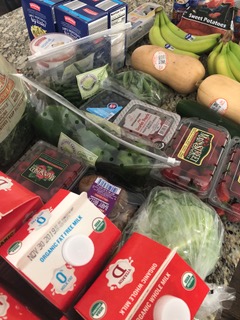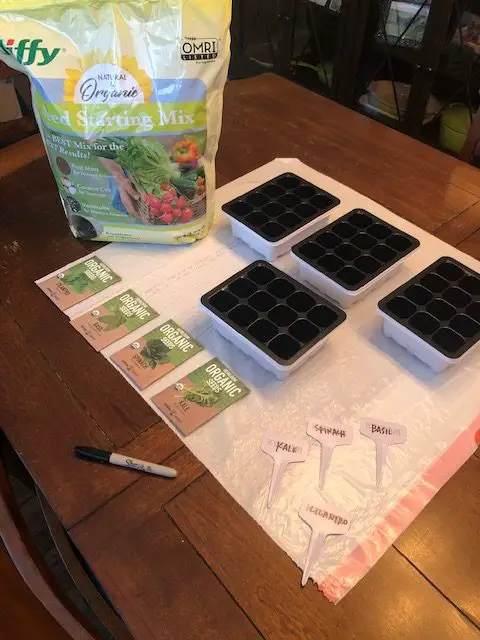We all have to buy food. It is one expense that never goes away. We eat most of our meals at home and with five people, our grocery bill can get out of control fast. As our family has grown over the years, I have learned different strategies to save money on groceries.
My goal is always to maximize the “bang for my buck” to get nutritious, quality, and tasty food for the least amount of money. I’ve found there are doable changes we can make to eat healthy, stay sane, and stay on track financially.
Here are my top tips for saving money on groceries:
1. Shop at Aldi
Aldi is a no-frills, discount grocery store and shopping there saves me a ton of money on groceries. I love Aldi, but shopping there did take some getting used to. Aldi carries a lot of their own brands of foods and doesn’t stock a lot of name brand items. I don’t have any complaints about their brands; Actually, I find a lot of high quality, organic items there. I really love their prices. I estimate that our grocery bill is about a third less when I shop at Aldi vs. other stores in our area.

2. Shop your shelves, first.
Before heading to the grocery, it’s best to take stock of what you already have. There is no sense in spending more money on things you’ve already bought. This is something I don’t always want to do, but I remind myself that spending three minutes looking through my pantry, refrigerator, and freezer is worth it. I try to decide what meals to make that week based on what we already have and might spoil soon. For instance, we have a bag of carrots left from last week. I decided to make a roast with carrots for dinner this week, and didn’t have to buy a new vegetable.
3. Use ingredient substitutions in recipes
Knowing how to substitute various ingredients for others can save you a bundle of money on groceries because you will be able to completely eliminate the need to buy certain things. I have found that often I can use an ingredient I already have to replace one I would need to buy. For instance, I don’t buy taco spice mix. Instead I google a recipe and mix spices I already have to make one. I don’t buy buttermilk because I know I can mix milk and a little vinegar to make my own. I will also substitute a less expensive ingredient in place of a more expensive one. If a recipe calls for ground beef but ground turkey is on sale, I might substitute the turkey for beef.
I first started substituting ingredients when I would try to make a recipe and realized I didn’t have one ingredient. I would google “a good substitute for ____.” After doing this a few times, I realized I did not need to buy the ingredient I was substituting for in the first place. There isn’t always a substitute for an ingredient. But by being resourceful and flexible when cooking, you can often save some money.
If this is a new concept for you, I’d start by trying to cut just one item off your grocery list each time you go shopping. This will gradually build your knowledge of what you can substitute. Putting a little bit of effort into this will simplify your pantry. You’ll likely have fewer random things on your shelves.
4. Minimize food waste
When we throw food away, we are throwing money away. In our home, I noticed that we were throwing a lot of food away that’s left on our kids’ plates. We might serve them a PB&J sandwich, they’d eat a third of it, and then the rest would get tossed. Now I make an effort to package up leftovers and serve them at a later time.
There are limits to my food salvaging; I do not collect popcorn pieces off the floor or keep food that looks flat out disgusting. However, I do keep the stuff that is still perfectly fine after a meal. I also have been trying to serve them just a few bites of each food in the first place. It’s easy enough to add more and there’s less of a chance that it ends up on the floor.
I’ve also made an effort to use up leftovers by having pot luck style-dinners about once a week. At these dinners, I heat up and serve the leftovers in our fridge. This is useful for using meals that I have a few servings of but not enough to make a whole meal. There might be a few slices of pizza, a pasta salad, a roasted vegetable, and some baked chicken. I got this idea from the Frugal Friends podcast and I love it. Potluck meals mean I get off the hook on preparing a new meal. I thought my family might whine a little about it, but that hasn’t been the case. My kids actually love that they can choose from a wide array of items to eat.
5. Limit costly beverages
Our family could spend a fortune on drinks. There are some that we really can’t go without (ahem, coffee) but others we can drink less of or not at all. In particular, we have started limiting the amount of soft drinks and milk that we buy.
6. Stretch pricier ingredients, like meat
Meat is usually the most expensive category of food on our grocery list. I use a few strategies to limit the amount of meat I buy. I will make meat go further by using it as a small component of a meal. We use chicken in a soup, stir fry or pasta where only a few pieces are needed to make the meal. I also sometimes add potatoes or beans to ground beef for tacos to decrease the amount of beef I need.
I also make dishes that don’t have any meat or seafood. Our favorites are pasta with roasted vegetables, tomato soup and grilled cheese, and vegetable fried rice.
7. Use budget recipes regularly
Over the years, I have learned how to make a few meals that cost very little money, and I fall back on them regularly to save money on groceries. Pasta and marinara is our number one go-to, but we also eat rice and beans, fried rice, and homemade pizza. Thinking of dishes where the main ingredient is an inexpensive one, like pasta, beans, and rice, is a good place to start.
8. Bananas
Bananas might be the best budget-friendly food. They are ready to eat, nutritious, can be taken on the go, and inexpensive. Bananas make a very inexpensive breakfast or snack, as well as a flavoring in any baked good. Banana muffins are generally less expensive to make than blueberry muffins. Banana pancakes or banana oatmeal is a special version of the plain stuff. It might seem strange to make an entire tip about bananas, but my love for bananas runs deep.
9. Limit convenience foods
Lots of convenience foods have made it on my grocery list over the years and I have learned the hard way that their costs add up. Pancake mix, oatmeal packets, cake mix, and cornbread mix are some convenience foods that I have cut out altogether. It is less expensive to buy bulk baking ingredients like flour, sugar, eggs, and butter and use those to bake.

I also stopped buying individual snack packs for my kids as much as possible. Per ounce, it’s less expensive to buy a big box than the individual servings. Also, those little packets of crackers, applesauce, chips, cereal, etc. produce a lot of plastic waste. It makes more sense for us to buy bulk snacks and distribute them into cups or bowls for each kid.
We are not a perfect example of this. I usually keep one box of individual snack items as a treat for my kids. I pull these out when we’re going somewhere challenging, like the dentist or to get the oil changed in our car. They think it’s so special to have these treats and under those circumstances, it is worth every penny to win their cooperation.
Through different stages, our family has relied more on convenience foods. When we had newborn twins at home, for example, we needed quick easy foods to grab and eat between feeding babies and changing diapers. I absolutely bought more convenience foods during that time. Now, I have a little bit more time and a desire to learn how to cook the old-fashioned way. I buy more whole foods and basic ingredients. There is no right way for everyone and we’re all able to put in more and less effort into managing meals at different phases of life. No shame or guilt here.

10. Grow your own food
Growing your own food can be an awesome way to save money on groceries. I’m just at the beginning of growing our own garden. I plan to grow tomatoes, herbs, kale and spinach this year. I don’t expect it to save a fortune, especially with the start-up costs, but the food we grow will help us save money on groceries this summer and early fall. Every little bit helps. Check out my Tips for New Gardeners!
I’d love to hear your thoughts on the ways you and your family save money on groceries! Please leave a comment below.
Disclaimer: The information published in this blog is for entertainment and informational purposes only. I am not an expert and you should look elsewhere for advice. Readers should do their own research and consult with real experts regarding their finances. I am not a financial expert. I am not liable for any damages resulting from using the information on this blog. All activities for children should be done with adult supervision.
Affiliate Information: I am a member of the Amazon Associates program and this post contains affiliate links, which means that if you buy something through one of the links here, I may receive payment at no additional cost to you. As an Amazon Associate, I earn from qualifying purchases.

6 replies on “10 Ways to Save Money on Groceries”
Bananas are my favorite way to keep my kids fed and my grocery bill down too!
Yes! I don’t think I’ve met a kid that doesn’t love bananas! Thanks for reading.
Loved the tips and we have started to grow our own garden this year too!
That’s great, Sarah! I can’t wait to get my seedlings outside! Thanks for reading.
I never realized how great Aldi was before the last few months! I’m totally obsessed now!
Yes, I love Aldi! I am considering doing a post on our favorite Aldi products. Thanks for reading, Erin.